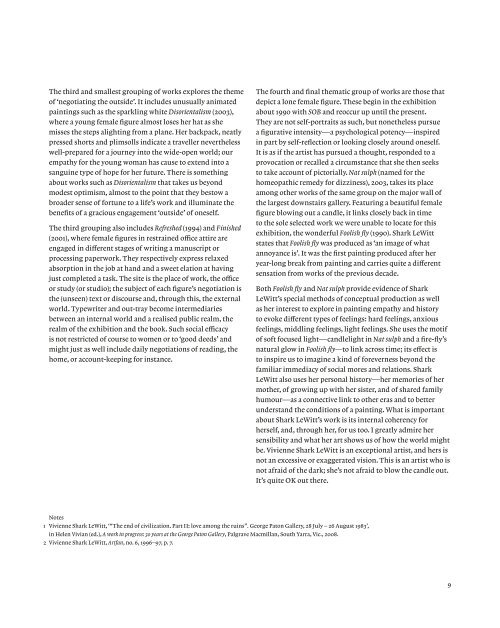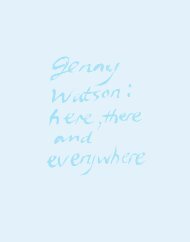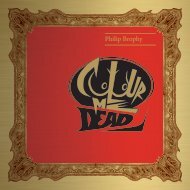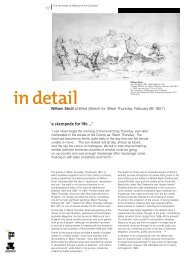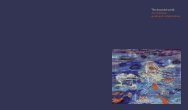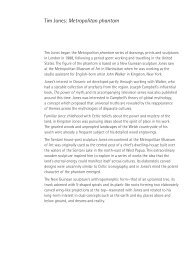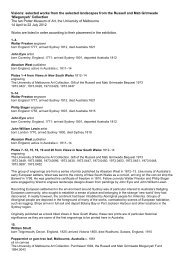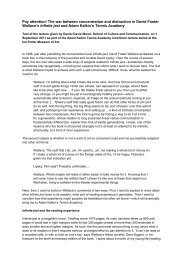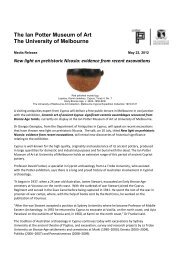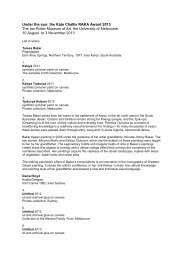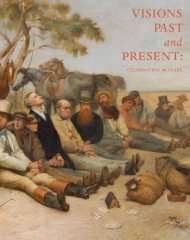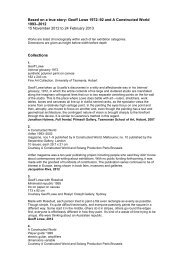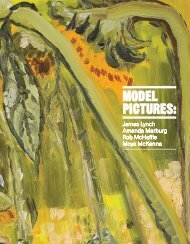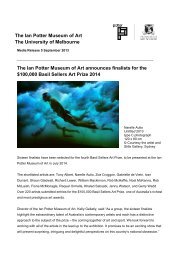Vivienne Shark LeWitt comedies & proverbs
Vivienne Shark LeWitt: comedies & proverbs - Ian Potter Museum of ...
Vivienne Shark LeWitt: comedies & proverbs - Ian Potter Museum of ...
Create successful ePaper yourself
Turn your PDF publications into a flip-book with our unique Google optimized e-Paper software.
The third and smallest grouping of works explores the theme<br />
of ‘negotiating the outside’. It includes unusually animated<br />
paintings such as the sparkling white Disorientalism (2003),<br />
where a young female figure almost loses her hat as she<br />
misses the steps alighting from a plane. Her backpack, neatly<br />
pressed shorts and plimsolls indicate a traveller nevertheless<br />
well-prepared for a journey into the wide-open world; our<br />
empathy for the young woman has cause to extend into a<br />
sanguine type of hope for her future. There is something<br />
about works such as Disorientalism that takes us beyond<br />
modest optimism, almost to the point that they bestow a<br />
broader sense of fortune to a life’s work and illuminate the<br />
benefits of a gracious engagement ‘outside’ of oneself.<br />
The third grouping also includes Refreshed (1994) and Finished<br />
(2001), where female figures in restrained office attire are<br />
engaged in different stages of writing a manuscript or<br />
processing paperwork. They respectively express relaxed<br />
absorption in the job at hand and a sweet elation at having<br />
just completed a task. The site is the place of work, the office<br />
or study (or studio); the subject of each figure’s negotiation is<br />
the (unseen) text or discourse and, through this, the external<br />
world. Typewriter and out-tray become intermediaries<br />
between an internal world and a realised public realm, the<br />
realm of the exhibition and the book. Such social efficacy<br />
is not restricted of course to women or to ‘good deeds’ and<br />
might just as well include daily negotiations of reading, the<br />
home, or account-keeping for instance.<br />
The fourth and final thematic group of works are those that<br />
depict a lone female figure. These begin in the exhibition<br />
about 1990 with SOB and reoccur up until the present.<br />
They are not self-portraits as such, but nonetheless pursue<br />
a figurative intensity—a psychological potency—inspired<br />
in part by self-reflection or looking closely around oneself.<br />
It is as if the artist has pursued a thought, responded to a<br />
provocation or recalled a circumstance that she then seeks<br />
to take account of pictorially. Nat sulph (named for the<br />
homeopathic remedy for dizziness), 2003, takes its place<br />
among other works of the same group on the major wall of<br />
the largest downstairs gallery. Featuring a beautiful female<br />
figure blowing out a candle, it links closely back in time<br />
to the sole selected work we were unable to locate for this<br />
exhibition, the wonderful Foolish fly (1990). <strong>Shark</strong> <strong>LeWitt</strong><br />
states that Foolish fly was produced as ‘an image of what<br />
annoyance is’. It was the first painting produced after her<br />
year-long break from painting and carries quite a different<br />
sensation from works of the previous decade.<br />
Both Foolish fly and Nat sulph provide evidence of <strong>Shark</strong><br />
<strong>LeWitt</strong>’s special methods of conceptual production as well<br />
as her interest to explore in painting empathy and history<br />
to evoke different types of feelings: hard feelings, anxious<br />
feelings, middling feelings, light feelings. She uses the motif<br />
of soft focused light—candlelight in Nat sulph and a fire-fly’s<br />
natural glow in Foolish fly—to link across time; its effect is<br />
to inspire us to imagine a kind of foreverness beyond the<br />
familiar immediacy of social mores and relations. <strong>Shark</strong><br />
<strong>LeWitt</strong> also uses her personal history—her memories of her<br />
mother, of growing up with her sister, and of shared family<br />
humour—as a connective link to other eras and to better<br />
understand the conditions of a painting. What is important<br />
about <strong>Shark</strong> <strong>LeWitt</strong>’s work is its internal coherency for<br />
herself, and, through her, for us too. I greatly admire her<br />
sensibility and what her art shows us of how the world might<br />
be. <strong>Vivienne</strong> <strong>Shark</strong> <strong>LeWitt</strong> is an exceptional artist, and hers is<br />
not an excessive or exaggerated vision. This is an artist who is<br />
not afraid of the dark; she’s not afraid to blow the candle out.<br />
It’s quite OK out there.<br />
Notes<br />
1 <strong>Vivienne</strong> <strong>Shark</strong> <strong>LeWitt</strong>, ‘“The end of civilization. Part II: love among the ruins”. George Paton Gallery, 28 July – 26 August 1983’,<br />
in Helen Vivian (ed.), A work in progress: 30 years at the George Paton Gallery, Palgrave Macmillan, South Yarra, Vic., 2008.<br />
2 <strong>Vivienne</strong> <strong>Shark</strong> <strong>LeWitt</strong>, Artfan, no. 6, 1996–97, p. 7.<br />
9


